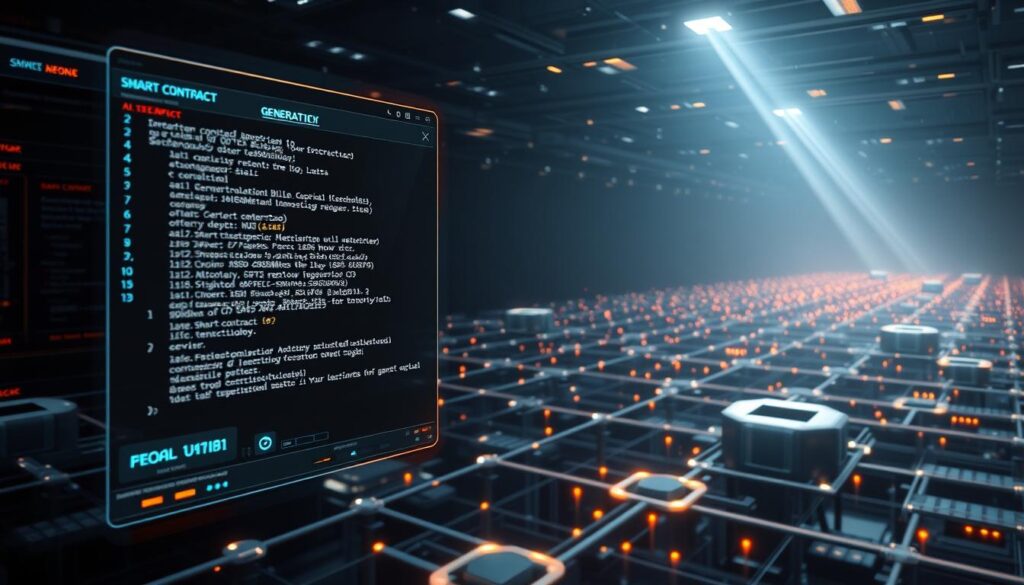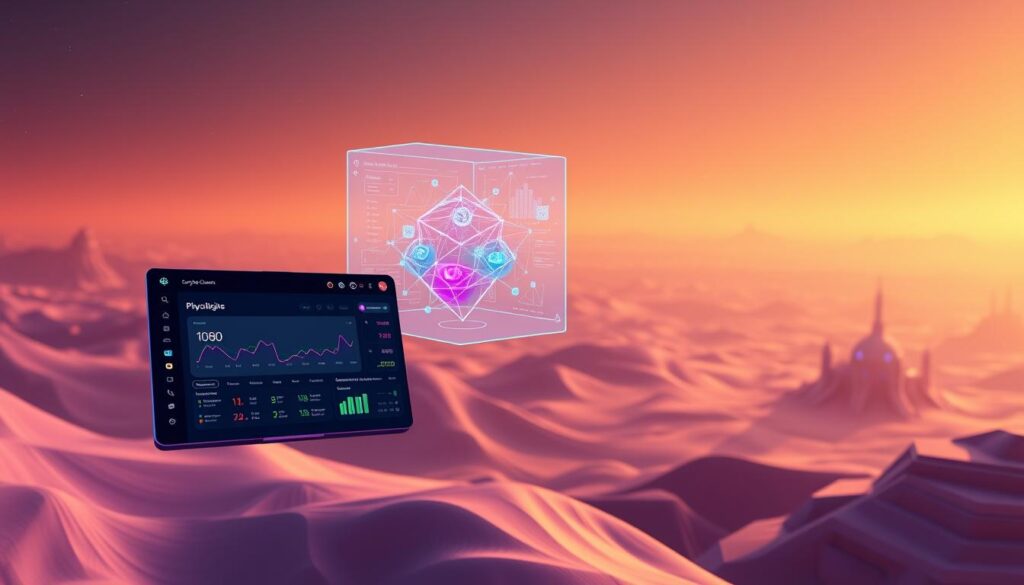Now Reading: AI Crypto Natural Language Processing Explained
- 01
AI Crypto Natural Language Processing Explained
AI Crypto Natural Language Processing Explained

A new wave of innovation is changing how we use digital money systems. This advancement combines smart computer programs with blockchain networks. The key is teaching machines to understand our everyday words.
This represents a major shift. Users no longer need deep technical knowledge. They can now talk to decentralized platforms like they would ask a friend for help. This makes powerful financial tools available to everyone.
The impact on the future of finance is significant. Complex tasks become simple conversations. This guide will explore how this works. We will look at real-world uses and the systems that make it possible.
You will learn about current applications in trading and data analysis. We will also cover the creation of smart contracts through simple instructions. The goal is to show how this technology bridges a critical gap.
It connects sophisticated protocols with users seeking straightforward experiences. The potential to transform digital finance is truly exciting.
Key Takeaways
- Machines can now understand human language to interact with blockchain systems.
- This technology moves user interaction from complex technical interfaces to simple conversations.
- It significantly lowers the barrier to entry for using cryptocurrency and decentralized finance.
- Non-technical users can execute complex operations by describing what they want in plain language.
- The guide will explore fundamental concepts, real-world applications, and future implications.
- This innovation has the potential to make sophisticated financial tools accessible to a mainstream audience.
Introduction: The Convergence of AI, Crypto, and Natural Language
A groundbreaking integration is reshaping digital finance by combining smart computational systems with blockchain infrastructure. This fusion creates interfaces that respond to everyday speech patterns.
Users can now engage with complex financial protocols using conversational queries. The technology interprets human intent rather than requiring specific commands.
Exploring the Intersection of AI and Decentralized Finance
Artificial intelligence brings sophisticated understanding to decentralized finance platforms. Systems can analyze market sentiment from social media and news sources.
This enables automated trading strategies that respond to real-time linguistic cues. The technology transforms how people interact with digital assets.
| Interaction Type | Traditional Approach | AI-Enhanced Approach | User Benefit |
|---|---|---|---|
| Wallet Queries | Technical commands | Natural language questions | Instant understanding |
| Market Analysis | Manual research | Automated sentiment reading | Time savings |
| Contract Creation | Complex coding | Plain text instructions | Accessibility |
| Governance Participation | Technical documentation | Simplified summaries | Broader inclusion |
Emerging Trends in Blockchain and NLP Innovations
New blockchain applications incorporate advanced language models directly into their architecture. These systems can generate smart contracts from simple descriptions.
The evolution from early conversational programs to current decentralized applications shows significant progress. Modern implementations focus on practical financial utilities.
Understanding AI Crypto Natural Language Processing
The technology that enables computers to comprehend human speech is fundamentally changing blockchain accessibility. This field allows systems to interpret user commands and vast amounts of unstructured data.
It transforms complex technical protocols into intuitive conversational interfaces.
The Fundamentals of Natural Language Processing in Crypto
These systems work by processing massive volumes of text data. They analyze words, identify patterns, and generate coherent outputs.
This process involves tagging information and creating predictive models. The goal is to understand user intent from simple descriptions.
For blockchain, this means users can ask questions in plain English. The system interprets the request and interacts with the protocol. This removes the need for specialized coding knowledge.
How Large Language Models Revolutionize Blockchain Interaction
Advanced models like GPT and BERT represent a significant leap forward. They can generate code, parse sentiment, and answer complex questions.
Their ability to understand context makes blockchain operations more accessible. This creates a seamless bridge between human language and digital finance systems.
| Model Type | Primary Function | Blockchain Application | User Impact |
|---|---|---|---|
| GPT Series | Text generation & code creation | Smart contract drafting | Simplifies development |
| BERT Model | Sentiment analysis & classification | Market trend analysis | Provides deeper insights |
| Multilingual Models | Cross-language understanding | Global protocol documentation | Expands accessibility |
These tools analyze data from news, social media, and user queries. They extract actionable insights to power decentralized applications. The result is a more intuitive and powerful user experience.
Smart Contracts and Decentralized Intelligence
Plain language descriptions are now transforming how complex financial agreements are created and deployed on distributed networks. This shift removes technical barriers that once limited participation to specialized developers.

Generating Smart Contracts from Plain Language
Projects like OpenLaw demonstrate this revolutionary capability. Users describe desired terms in everyday speech rather than requiring Solidity knowledge.
A visionary application involves typing requests like “Create a crowdfunding contract that releases funds only when 75% of participants approve.” The system interprets the prompt and builds the contract logic automatically.
| Approach | Technical Requirement | Development Time | Accessibility Level |
|---|---|---|---|
| Traditional Coding | Programming expertise | Days to weeks | Limited to developers |
| Language-Based Generation | Basic English understanding | Minutes | Available to everyone |
| Automated Deployment | No technical knowledge | Instant | Maximum inclusion |
Integrating NLP to Enhance DAO Governance and Operations
Decentralized organizations benefit significantly from these advancements. Natural language proposals receive automated summaries for clearer community understanding.
Systems can detect governance manipulation attempts and flag suspicious motions. This creates more participatory environments regardless of members’ technical background.
Projects like ChainGPT and Zama combine text interpretation with cryptographic privacy. They maintain security while expanding access to sophisticated financial tools.
Real-World Use Cases and Impact on Trading & Analytics
Concrete examples reveal how speech processing systems deliver competitive edges in volatile financial environments. These practical applications transform theoretical capabilities into daily tools.
NLP-Driven Trading Bots and Sentiment Analysis
LunarCrush demonstrates powerful use cases in market analytics. The platform scans millions of social posts daily. It assigns quantitative scores like “AltRank” based on engagement and sentiment.
Trading bots using nlp classify language as bullish or bearish. These signals help traders make better decisions. During volatile cycles, sentiment-based approaches often outperform traditional methods.
| Analytical Approach | Data Sources | Decision Speed | User Accessibility |
|---|---|---|---|
| Traditional Technical Analysis | Price charts, volume data | Manual interpretation | Requires chart reading skills |
| NLP-Enhanced Sentiment Analysis | Social media, news, forums | Real-time automated | Plain language insights |
| Hybrid Models | Combined technical & sentiment data | Rapid algorithmic processing | Dashboard visualization |

Analyzing Blockchain Data with Natural Language Queries
Kleros developed KAI, an assistant that guides users through arbitration cases. It reduces technical barriers for blockchain interactions.
Vector Space applications uncover hidden relationships among assets and events. Their models identify correlations invisible to traditional analysis. This provides deeper investment insights.
These cases show how language models transform complex data into accessible information. Users can extract blockchain insights through simple questions.
Building Next-Generation Interfaces with NLP and AI
Digital wallets are evolving from simple storage tools into intelligent financial companions. These advanced interfaces understand conversational patterns and provide personalized guidance.
They transform complex operations into natural intuitive exchanges. This represents a fundamental shift in how people interact with digital assets.

Creating Conversational Crypto Wallets
Projects like Rainbow Wallet demonstrate this evolution through plugin frameworks. These systems could integrate lightweight agents that understand everyday speech.
Imagine receiving proactive alerts like “Your yield on Pool A dropped 20% this week. Want to move to Pool B instead?” This transforms passive tools into active financial advisors.
The technology creates voice-activated assistants that make recommendations in plain English. This removes technical barriers for users seeking blockchain access.
Designing User-Centric Interfaces for DeFi Applications
Companies like Thought AI are building self-aware applications that learn from interactions. These systems eliminate traditional application layers through intelligent understanding.
The potential exists for no-knowledge platforms where anyone can deploy products using simple chatbot interfaces. This represents revolutionary access to decentralized tools.
These user-centric designs make sophisticated financial applications available to multilingual and non-technical audiences. They represent the future of inclusive blockchain technology.
Exploring Data and Infrastructure through AWS and Bedrock
The infrastructure supporting conversational access to blockchain networks represents a critical advancement in data accessibility. Public ledgers hold a wealth of information, but it is often stored in complex, encoded formats.
This makes direct querying difficult for analysts. Specialized tools are needed to transform this raw data into usable insights.
Leveraging Amazon Bedrock for Autonomous Agents
Amazon Bedrock provides a fully managed service for building intelligent applications. It offers access to powerful foundation models and tools for creating autonomous agents.
These agents can understand user requests in plain English. They break down complex tasks and execute them by calling APIs.

A key example involves querying blockchain datasets. Users can ask, “What was the largest Bitcoin transaction yesterday?” The agent interprets this, generates the correct SQL query, and returns the result.
This process includes robust error handling. If a query fails, the agent analyzes the error and reformulates the query automatically.
Optimizing Blockchain Data Querying with ETL and BI Tools
Before analysis, raw blockchain data must be processed. Extract, transform, and load (ETL) pipelines convert it into a format for business intelligence tools.
The AWS Public Blockchain dataset simplifies this for Bitcoin and Ethereum. It allows analysts to run SQL queries using services like Amazon Athena.
| Query Method | Data Scanned | Response Time | Approximate Cost |
|---|---|---|---|
| Traditional Athena Query | 1.15 TB | 40 seconds | $6.00 USD |
| Optimized AMB Query | Minimal | Milliseconds | $0.000007 USD |
This infrastructure layer democratizes data access. It empowers users to gain knowledge without deep technical expertise. Integration with projects like The Graph could further expand these capabilities across networks.
Conclusion
We stand at the threshold where spoken words can execute complex financial operations on distributed networks. This technology fundamentally transforms how people interact with digital assets through simple conversation.
The future holds immense potential as voice interfaces make sophisticated tools accessible to everyone. Major financial institutions already recognize this shift, with nearly half adopting similar technology for better decisions.
Despite exciting progress, issues around regulation and content moderation require balanced approaches. The role of responsible development cannot be overlooked in this rapid evolution.
This convergence represents an irreversible shift that will define the next series of innovations. New ways of interacting with blockchain data through natural conversation point toward an inclusive future for decentralized finance.
FAQ
What is the primary goal of combining natural language processing with blockchain technology?
The main goal is to make interacting with complex systems like decentralized finance (DeFi) much simpler. Instead of needing technical knowledge, users can use plain English to query data, execute trades, or even generate smart contracts. This creates a more natural, intuitive interface for everyone.
How can large language models improve how we interact with smart contracts?
These advanced models can translate everyday language into precise code. For example, you could describe a contract’s terms in simple sentences, and the model would generate the corresponding Solidity code. This reduces errors and makes the technology accessible to a much wider audience without deep programming skills.
What role does sentiment analysis play in crypto trading?
Sentiment analysis tools scan vast amounts of text from news articles, social media, and forums to gauge market mood. Trading bots can use this understanding to make more informed, data-driven decisions. This helps traders react to public opinion shifts that might not be immediately visible in price charts alone.
Can you give an example of a user-centric interface powered by this technology?
A conversational crypto wallet is a great example. Imagine asking your wallet, “Send 50 USDC to Maria for the dinner bill,” or “What was my largest Ethereum transaction last month?” The wallet, using natural language understanding, would execute the command or provide the answer, removing the need to navigate complex menus.
How do platforms like Amazon Bedrock contribute to building autonomous agents in this space?
Amazon Bedrock provides access to powerful foundation models, allowing developers to build sophisticated applications. In the blockchain world, this means creating autonomous agents that can understand complex queries, analyze on-chain data, and perform actions based on a user’s natural language instructions, all while leveraging robust cloud infrastructure.














